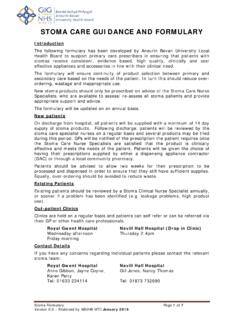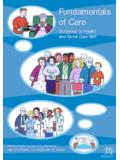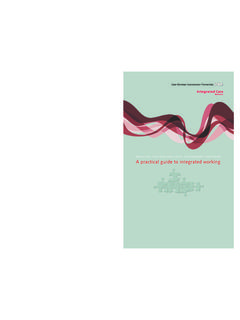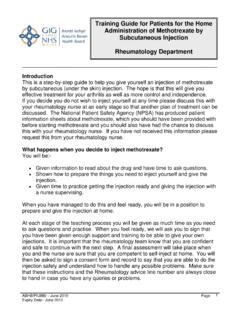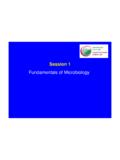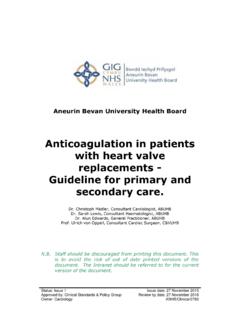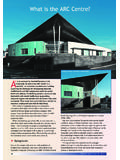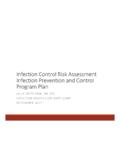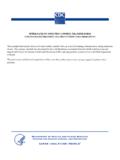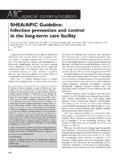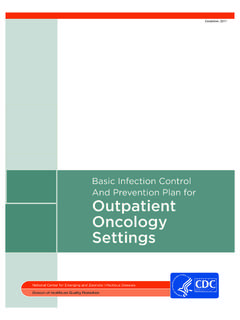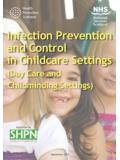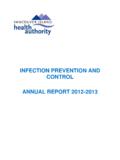Transcription of Good practice in infection prevention and control - …
1 Good practice in infectionprevention and controlGuidance for nursing staffNote about languageThe term patient has been used throughout this textbut this can also be understood to mean client publication contains information, advice and guidance tohelp members of the RCN. It is intended for use within the UKbut readers are advised that practices may vary in each countryand outside the UK. The information in this booklet has been compiled fromprofessional sources, but its accuracy is not guaranteed. Whilstevery effort has been made to ensure the RCN provides accurateand expert information and guidance, it is impossible to predictall the circumstances in which it may be used. Accordingly, theRCN shall not be liable to any person or entity with respect toany loss or damage caused or alleged to be caused directly orindirectly by what is contained in or left out of this websiteinformation and by the Royal College of Nursing, 20 Cavendish Square,London, W1G 0RN 2005 Royal College of Nursing.
2 All rights reserved. No part ofthis publication may be reproduced, stored in a retrieval system,or transmitted in any form or by any means electronic,mechanical, photocopying, recording or otherwise, withoutprior permission of the Publishers or a licence permittingrestricted copying issued by the Copyright Licensing Agency, 90 Tottenham Court Road, London W1T 4LP. This publication maynot be lent, resold, hired out or otherwise disposed of by ways oftrade in any form of binding or cover other than that in which itis published, without the prior consent of the [fromhospital acquired infection ]vary from discomfort forthe patient to prolonged orpermanent disability and asmall proportion of patientdeaths each year areprimarily attributable tohospital acquiredinfections.
3 (National Audit Office, 2000)ROYAL COLLEGE OF NURSING1 Good practice in infectionprevention and controlGuidance for nursing staff ContentsForeword2 Introduction 3 The general principles of infection prevention and control hygiene personal protective equipment handling and disposal of sharps handling and disposal of chemical blood and bodily fluids6 Spillages 6 Collecting, handling and labelling of specimens equipment7 Cleaning 7 Disinfection 8 Sterilisation and maintaining a clean clinical use of indwelling accidental exposure to blood-borne virus1010.
4 Good communication1111. Training11 Variant Creutzfeldt Jakob Disease (vCJD) 12 Methicillin-resistant Staphylococcus aureus(MRSA)12 References 12 Useful reading 13 Usef ul websites 15 Glossary15 Appendix 1 infection control checklist 1610-Step handwashing guideInside Back Cover2 GOOD practice IN infection prevention AND CONTROLF orewordInfection prevention and control is deservedly high on the agendafor patients, nurses and decision makers. The RCN Wipe it Outcampaign is part of our mission to promote excellence in updated guidance will be a valuable tool to help you and yourteam reduce the prevalence of health care associated infections (HCAIs). Use it together with the other Wipe it Out leaflets andposters to promote good practice .
5 It will help you to spare patients anxiety, pain, inconvenience, disability and even control is an essential component of care and one whichhas too often been undervalued in recent years. The frontlines oftwenty-first century care combine tremendous technology andexpertise side by side with staff shortages and concerns abouthygiene. Patients and their families are concerned about whetherwe are getting the basics right nutrition, dignity, washing is far less glamorous than hi-tech interventions, butit is known to be the single most important thing we can do toreduce the spread of disease. By encouraging good practice amongmembers of the health care team and visitors you will behelping safe working environment is a safe caring environment.
6 Thisguidance covers important issues including disposing of waste,managing sharps, blood and bodily fluids as well as achieving andmaintaining a clean clinical environment. You will be able toappreciate how to put the guidance into practice whether younurse in hospital, in general practice or in patients may also appreciate that improvements need to be made ininfection prevention and control in your workplace. This is anopportunity for you to share evidence on best practice , buildsupport from colleagues, patients, other departments and otherorganisations and present the convincing case for change. It is partof transforming the culture of health care through raisingstandards and designing person-centred services. It is as centralto patient care as effective hand RCN is calling for a number of improvements, includingtraining in infection control for all health care staff, 24 houravailability of cleaning teams and onsite provision of staffuniforms and changing facilities.
7 By campaigning together, wecan bring about significant positive improvements for patients,the public and the health care Malone RN PhD FAANG eneral SecretaryIntroductionAs part of its Wipe it out campaign the Royal Collegeof Nursing has revised its guidance on good practicein infection prevention and control . This new updatedguidance emphasises the key roles that nursing staffand other health care workers in the NHS andindependent sector have in helping to reduce theprevalence of health care associated infections (HCAIs).Every health care worker plays a vital part in helpingto minimise the risk of cross infection for example,by making certain that hands are properly washed,the clinical environment is as clean as possible,ensuring knowledge and skills are continuallyupdated and by educating patients and publication includes information on the generalprinciples of infection prevention and control ,including standard infection prevention and controlpractice, decontamination, achieving andmaintaining a clean clinical environment, what to doin the event of an invasive injury/accident, and theimportance of good communication.
8 Two smallsections give guidance on variant Creutzfeldt JakobDisease (vCJD) and methicillin-resistantStaphylococcus aureus (MRSA). There is also a Usef ulinformation section with signposts to initiatives andpolicies being implemented around the generalprinciples ofinfection preventionand control (standard precautions)Standard precautions (formerly known as universalprecautions) underpin routine safe practice ,protecting both staff and clients from infection . Byapplying standard precautions at all times and to allpatients, best practice becomes second nature and therisks of infection are minimised. They include:1achieving optimum hand hygiene2using personal protective equipment3safe handling and disposal of sharps4safe handling and disposal of clinical waste5managing blood and bodily fluids6decontaminating equipment7achieving and maintaining a clean clinicalenvironment8appropriate use of indwelling devices9managing accidents10good communication with other health careworkers, patients and visitors11 COLLEGE OF NURSING31.
9 Hand hygieneHand hygiene is widely acknowledged to be the singlemost important activity for reducing the spread ofdisease, yet evidence suggests that many health careprofessionals do not decontaminate their hands asoften as they need to or use the correct techniquewhich means that areas of the hands can be diagram on page 5 demonstrates the handhygiene procedure that should be followed whenwashing with soap and water or using an alcoholhand gel or T I C E I N I N F E C T I O N C O N T R O LHands should be decontaminated before directcontact with patients and after any activity orcontact that contaminates the hands, includingfollowing the removal of gloves. While alcohol handgels and rubs are a practical alternative to soap andwater, alcohol is not a cleaning agent.
10 Hands that arevisibly dirty or potentially grossly contaminatedmust be washed with soap and water and driedthoroughly. Hand preparation increases theeffectiveness of decontamination. You should: keep nails short, clean and polish free avoid wearing wrist watches and jewellery,especially rings with ridges or stones artificial nails must not be worn any cuts and abrasions should be covered with awaterproof your wristwatch and any bracelets and rollup long sleeves before washing your hands (andwrists). In addition, bear in mind the followingpoints:FacilitiesAdequate hand washing facilities must be availableand easily accessible in all patient areas, treatmentrooms, sluices and kitchens. Basins in clinical areasshould have elbow or wrist lever operated mixer tapsor automated controls and be provided with liquidsoap dispensers, paper hand towels and foot-operatedwaste bins (NHS Estates, 2002).

